Exploring the Relationship between Performance Appraisal and Employee Motivation
VerifiedAdded on 2019/12/03
|12
|3647
|192
Report
AI Summary
The provided assignment content explores the theoretical study and comparison of literature on expatriate performance appraisal. The selected articles discuss various aspects of employee motivation, job satisfaction, and organizational performance. The content highlights the importance of performance appraisal in improving employee productivity and motivation. Additionally, it touches upon the role of self-theories, classical motivation theories, and knowledge management in understanding expatriate performance. Overall, the assignment aims to provide a comprehensive overview of the literature on expatriate performance appraisal.
Contribute Materials
Your contribution can guide someone’s learning journey. Share your
documents today.
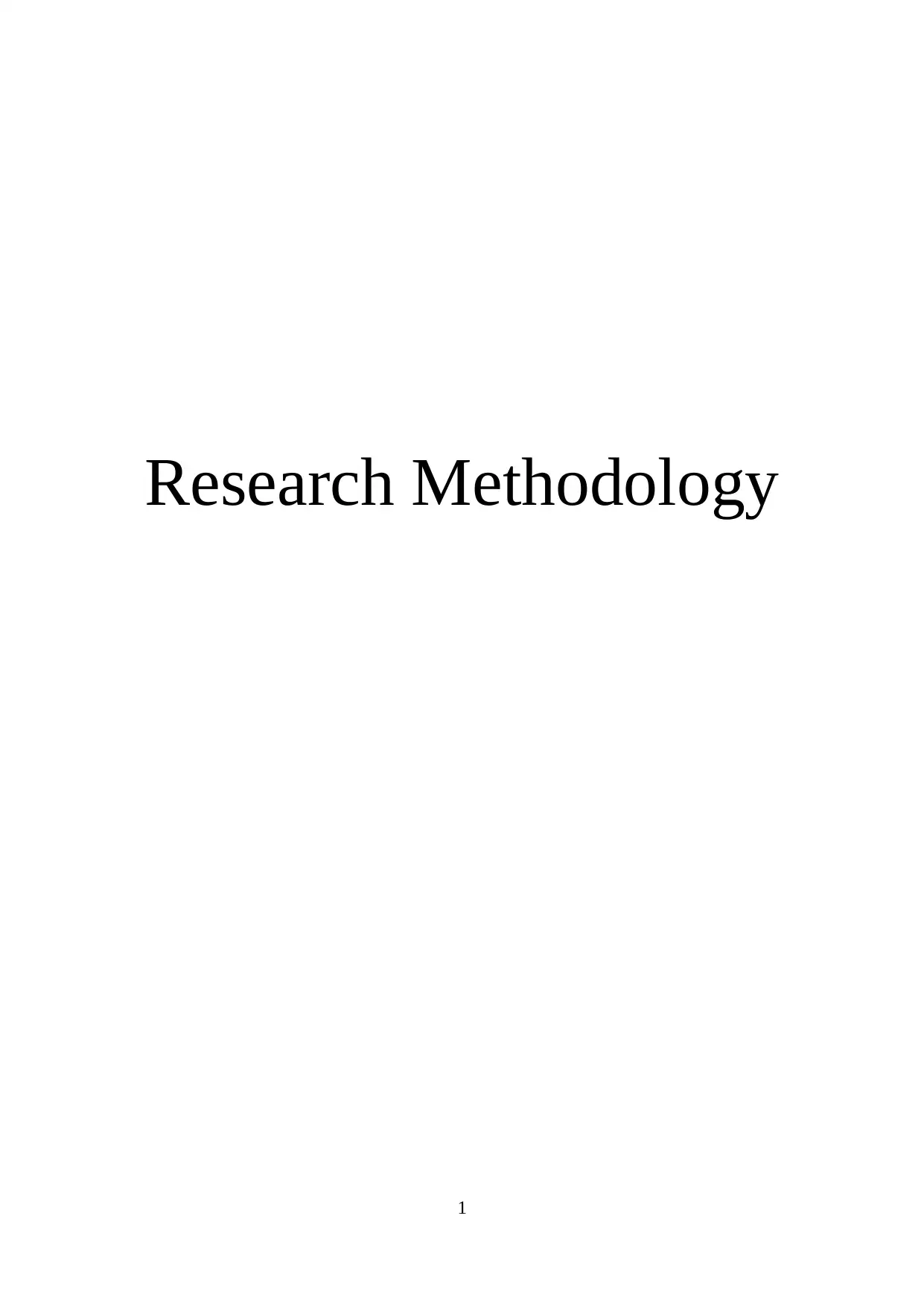
Research Methodology
1
1
Secure Best Marks with AI Grader
Need help grading? Try our AI Grader for instant feedback on your assignments.
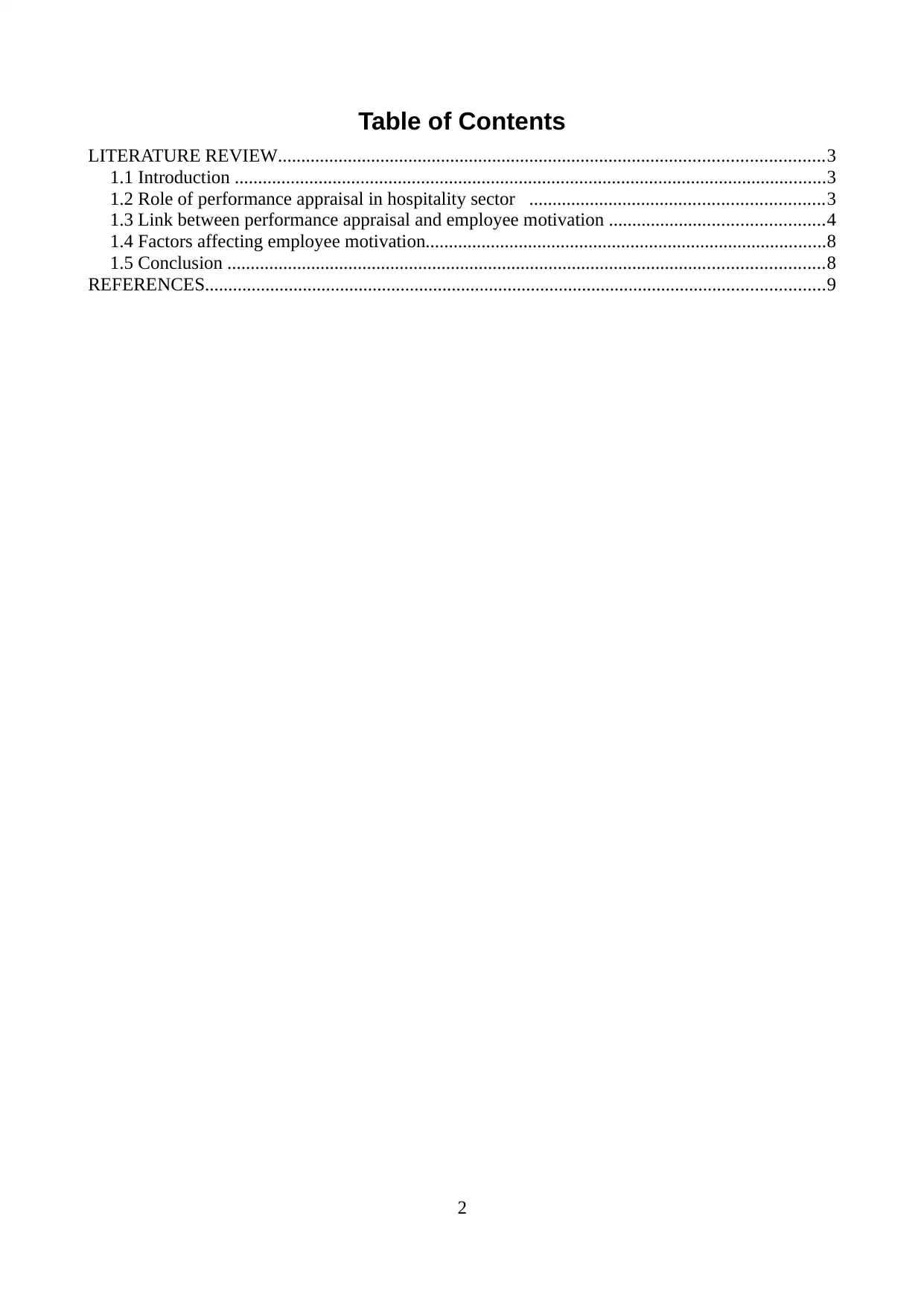
Table of Contents
LITERATURE REVIEW.....................................................................................................................3
1.1 Introduction ...............................................................................................................................3
1.2 Role of performance appraisal in hospitality sector ...............................................................3
1.3 Link between performance appraisal and employee motivation ..............................................4
1.4 Factors affecting employee motivation......................................................................................8
1.5 Conclusion ................................................................................................................................8
REFERENCES.....................................................................................................................................9
2
LITERATURE REVIEW.....................................................................................................................3
1.1 Introduction ...............................................................................................................................3
1.2 Role of performance appraisal in hospitality sector ...............................................................3
1.3 Link between performance appraisal and employee motivation ..............................................4
1.4 Factors affecting employee motivation......................................................................................8
1.5 Conclusion ................................................................................................................................8
REFERENCES.....................................................................................................................................9
2

Illustration Index
Illustration 1: Performance appraisal cycle..........................................................................................6
3
Illustration 1: Performance appraisal cycle..........................................................................................6
3
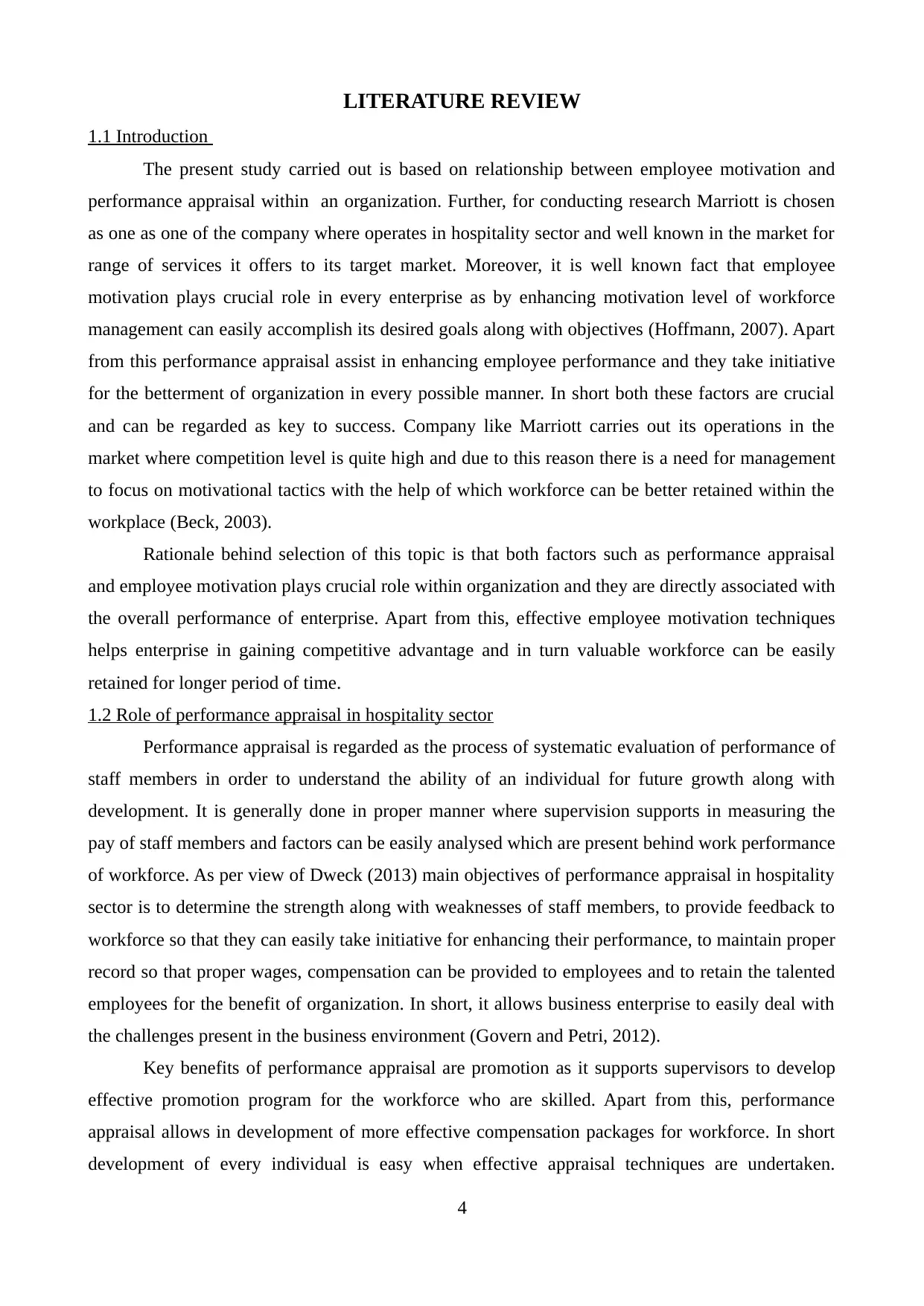
LITERATURE REVIEW
1.1 Introduction
The present study carried out is based on relationship between employee motivation and
performance appraisal within an organization. Further, for conducting research Marriott is chosen
as one as one of the company where operates in hospitality sector and well known in the market for
range of services it offers to its target market. Moreover, it is well known fact that employee
motivation plays crucial role in every enterprise as by enhancing motivation level of workforce
management can easily accomplish its desired goals along with objectives (Hoffmann, 2007). Apart
from this performance appraisal assist in enhancing employee performance and they take initiative
for the betterment of organization in every possible manner. In short both these factors are crucial
and can be regarded as key to success. Company like Marriott carries out its operations in the
market where competition level is quite high and due to this reason there is a need for management
to focus on motivational tactics with the help of which workforce can be better retained within the
workplace (Beck, 2003).
Rationale behind selection of this topic is that both factors such as performance appraisal
and employee motivation plays crucial role within organization and they are directly associated with
the overall performance of enterprise. Apart from this, effective employee motivation techniques
helps enterprise in gaining competitive advantage and in turn valuable workforce can be easily
retained for longer period of time.
1.2 Role of performance appraisal in hospitality sector
Performance appraisal is regarded as the process of systematic evaluation of performance of
staff members in order to understand the ability of an individual for future growth along with
development. It is generally done in proper manner where supervision supports in measuring the
pay of staff members and factors can be easily analysed which are present behind work performance
of workforce. As per view of Dweck (2013) main objectives of performance appraisal in hospitality
sector is to determine the strength along with weaknesses of staff members, to provide feedback to
workforce so that they can easily take initiative for enhancing their performance, to maintain proper
record so that proper wages, compensation can be provided to employees and to retain the talented
employees for the benefit of organization. In short, it allows business enterprise to easily deal with
the challenges present in the business environment (Govern and Petri, 2012).
Key benefits of performance appraisal are promotion as it supports supervisors to develop
effective promotion program for the workforce who are skilled. Apart from this, performance
appraisal allows in development of more effective compensation packages for workforce. In short
development of every individual is easy when effective appraisal techniques are undertaken.
4
1.1 Introduction
The present study carried out is based on relationship between employee motivation and
performance appraisal within an organization. Further, for conducting research Marriott is chosen
as one as one of the company where operates in hospitality sector and well known in the market for
range of services it offers to its target market. Moreover, it is well known fact that employee
motivation plays crucial role in every enterprise as by enhancing motivation level of workforce
management can easily accomplish its desired goals along with objectives (Hoffmann, 2007). Apart
from this performance appraisal assist in enhancing employee performance and they take initiative
for the betterment of organization in every possible manner. In short both these factors are crucial
and can be regarded as key to success. Company like Marriott carries out its operations in the
market where competition level is quite high and due to this reason there is a need for management
to focus on motivational tactics with the help of which workforce can be better retained within the
workplace (Beck, 2003).
Rationale behind selection of this topic is that both factors such as performance appraisal
and employee motivation plays crucial role within organization and they are directly associated with
the overall performance of enterprise. Apart from this, effective employee motivation techniques
helps enterprise in gaining competitive advantage and in turn valuable workforce can be easily
retained for longer period of time.
1.2 Role of performance appraisal in hospitality sector
Performance appraisal is regarded as the process of systematic evaluation of performance of
staff members in order to understand the ability of an individual for future growth along with
development. It is generally done in proper manner where supervision supports in measuring the
pay of staff members and factors can be easily analysed which are present behind work performance
of workforce. As per view of Dweck (2013) main objectives of performance appraisal in hospitality
sector is to determine the strength along with weaknesses of staff members, to provide feedback to
workforce so that they can easily take initiative for enhancing their performance, to maintain proper
record so that proper wages, compensation can be provided to employees and to retain the talented
employees for the benefit of organization. In short, it allows business enterprise to easily deal with
the challenges present in the business environment (Govern and Petri, 2012).
Key benefits of performance appraisal are promotion as it supports supervisors to develop
effective promotion program for the workforce who are skilled. Apart from this, performance
appraisal allows in development of more effective compensation packages for workforce. In short
development of every individual is easy when effective appraisal techniques are undertaken.
4
Secure Best Marks with AI Grader
Need help grading? Try our AI Grader for instant feedback on your assignments.
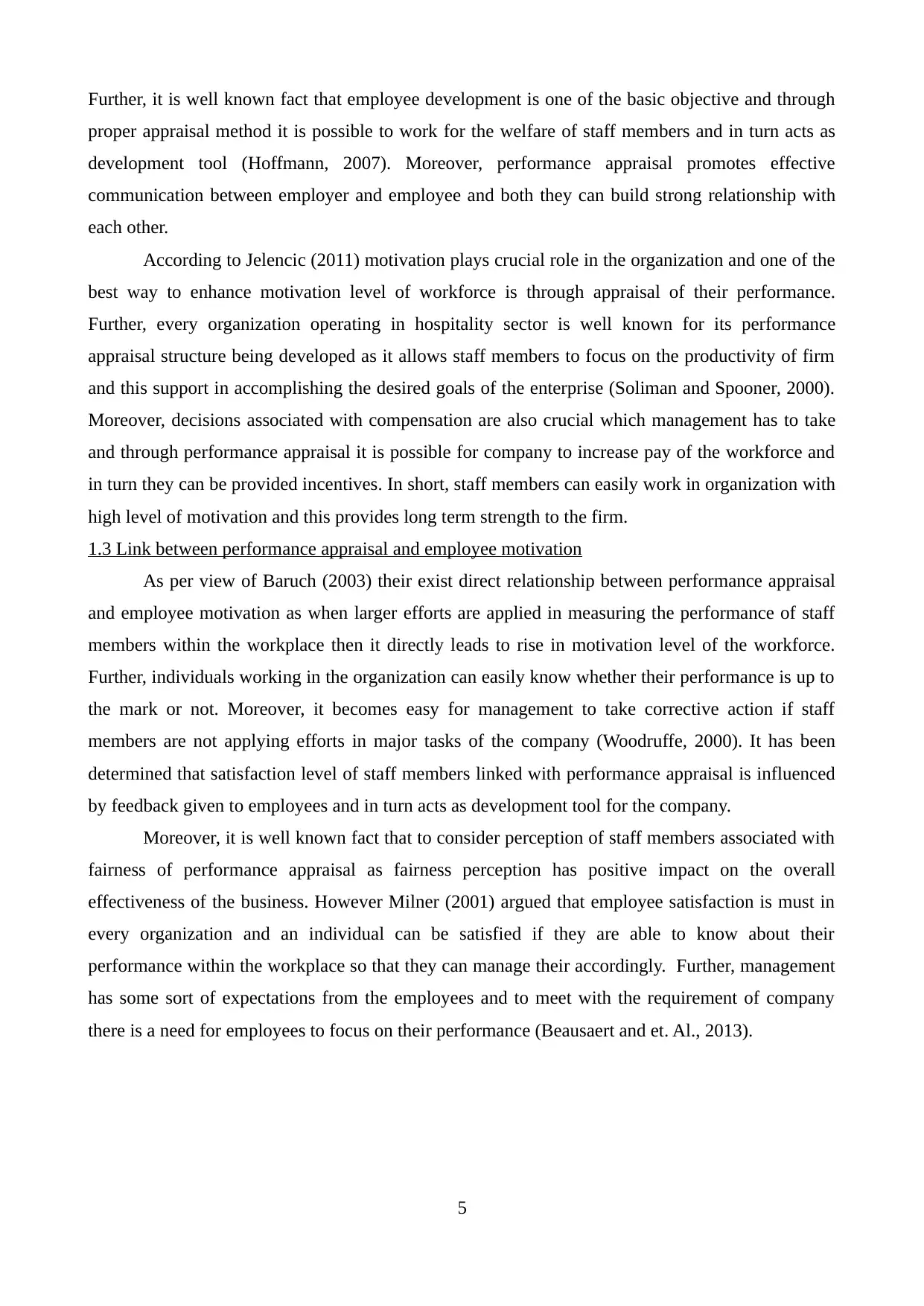
Further, it is well known fact that employee development is one of the basic objective and through
proper appraisal method it is possible to work for the welfare of staff members and in turn acts as
development tool (Hoffmann, 2007). Moreover, performance appraisal promotes effective
communication between employer and employee and both they can build strong relationship with
each other.
According to Jelencic (2011) motivation plays crucial role in the organization and one of the
best way to enhance motivation level of workforce is through appraisal of their performance.
Further, every organization operating in hospitality sector is well known for its performance
appraisal structure being developed as it allows staff members to focus on the productivity of firm
and this support in accomplishing the desired goals of the enterprise (Soliman and Spooner, 2000).
Moreover, decisions associated with compensation are also crucial which management has to take
and through performance appraisal it is possible for company to increase pay of the workforce and
in turn they can be provided incentives. In short, staff members can easily work in organization with
high level of motivation and this provides long term strength to the firm.
1.3 Link between performance appraisal and employee motivation
As per view of Baruch (2003) their exist direct relationship between performance appraisal
and employee motivation as when larger efforts are applied in measuring the performance of staff
members within the workplace then it directly leads to rise in motivation level of the workforce.
Further, individuals working in the organization can easily know whether their performance is up to
the mark or not. Moreover, it becomes easy for management to take corrective action if staff
members are not applying efforts in major tasks of the company (Woodruffe, 2000). It has been
determined that satisfaction level of staff members linked with performance appraisal is influenced
by feedback given to employees and in turn acts as development tool for the company.
Moreover, it is well known fact that to consider perception of staff members associated with
fairness of performance appraisal as fairness perception has positive impact on the overall
effectiveness of the business. However Milner (2001) argued that employee satisfaction is must in
every organization and an individual can be satisfied if they are able to know about their
performance within the workplace so that they can manage their accordingly. Further, management
has some sort of expectations from the employees and to meet with the requirement of company
there is a need for employees to focus on their performance (Beausaert and et. Al., 2013).
5
proper appraisal method it is possible to work for the welfare of staff members and in turn acts as
development tool (Hoffmann, 2007). Moreover, performance appraisal promotes effective
communication between employer and employee and both they can build strong relationship with
each other.
According to Jelencic (2011) motivation plays crucial role in the organization and one of the
best way to enhance motivation level of workforce is through appraisal of their performance.
Further, every organization operating in hospitality sector is well known for its performance
appraisal structure being developed as it allows staff members to focus on the productivity of firm
and this support in accomplishing the desired goals of the enterprise (Soliman and Spooner, 2000).
Moreover, decisions associated with compensation are also crucial which management has to take
and through performance appraisal it is possible for company to increase pay of the workforce and
in turn they can be provided incentives. In short, staff members can easily work in organization with
high level of motivation and this provides long term strength to the firm.
1.3 Link between performance appraisal and employee motivation
As per view of Baruch (2003) their exist direct relationship between performance appraisal
and employee motivation as when larger efforts are applied in measuring the performance of staff
members within the workplace then it directly leads to rise in motivation level of the workforce.
Further, individuals working in the organization can easily know whether their performance is up to
the mark or not. Moreover, it becomes easy for management to take corrective action if staff
members are not applying efforts in major tasks of the company (Woodruffe, 2000). It has been
determined that satisfaction level of staff members linked with performance appraisal is influenced
by feedback given to employees and in turn acts as development tool for the company.
Moreover, it is well known fact that to consider perception of staff members associated with
fairness of performance appraisal as fairness perception has positive impact on the overall
effectiveness of the business. However Milner (2001) argued that employee satisfaction is must in
every organization and an individual can be satisfied if they are able to know about their
performance within the workplace so that they can manage their accordingly. Further, management
has some sort of expectations from the employees and to meet with the requirement of company
there is a need for employees to focus on their performance (Beausaert and et. Al., 2013).
5

The four stage performance appraisal cycle is effective as through this performance of staff
members within workplace can be measured easily and in turn it provides direction to the
employees so that they can easily carry out operations within the company (Davies, 2006). The first
stage is define expectations which highlights what are the real expectations of management from its
workforce. Further, by meeting with the expectations of management employees can easily enhance
their performance which can be regarded as one of their major aim. As per view of McDowall
and Mabey (2008) expectations of top authorities of firm depends from one staff member to
another. Therefore, it is necessarily required for employees to take corrective actions so that they
can develop positive image in the mind of management. Second stage is measurement and
evaluation where overall work done by employees is measured by company and it is evaluated for
the betterment of workforce. In short, measurement of employee performance leads to rise in
motivation level and enhances job satisfaction (Afiouni, 2013). Due to this basic reason, hospitality
organizations measure performance of its workforce on continuous basis so that business enterprise
can easily gain competitive advantage with the help of this.
After measurement of performance feedback is provided to the staff members so that they
can take corrective actions for performance improvement and in turn company can easily sustain in
the market for long period of time. In short, providing feedback to employees on continuous basis
6
Illustration 1: Performance appraisal cycle
(Source: Cmolik, 2002)
members within workplace can be measured easily and in turn it provides direction to the
employees so that they can easily carry out operations within the company (Davies, 2006). The first
stage is define expectations which highlights what are the real expectations of management from its
workforce. Further, by meeting with the expectations of management employees can easily enhance
their performance which can be regarded as one of their major aim. As per view of McDowall
and Mabey (2008) expectations of top authorities of firm depends from one staff member to
another. Therefore, it is necessarily required for employees to take corrective actions so that they
can develop positive image in the mind of management. Second stage is measurement and
evaluation where overall work done by employees is measured by company and it is evaluated for
the betterment of workforce. In short, measurement of employee performance leads to rise in
motivation level and enhances job satisfaction (Afiouni, 2013). Due to this basic reason, hospitality
organizations measure performance of its workforce on continuous basis so that business enterprise
can easily gain competitive advantage with the help of this.
After measurement of performance feedback is provided to the staff members so that they
can take corrective actions for performance improvement and in turn company can easily sustain in
the market for long period of time. In short, providing feedback to employees on continuous basis
6
Illustration 1: Performance appraisal cycle
(Source: Cmolik, 2002)
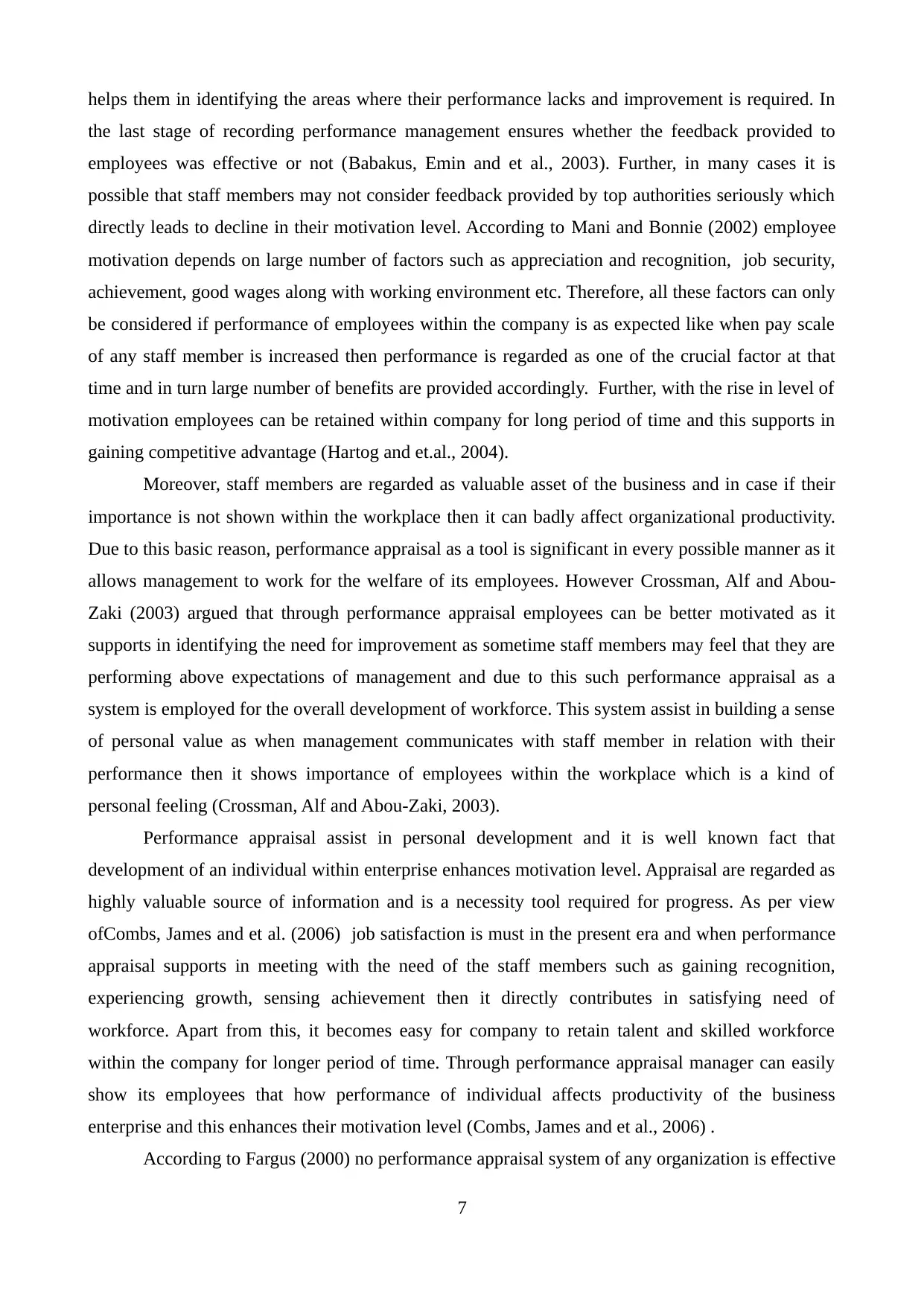
helps them in identifying the areas where their performance lacks and improvement is required. In
the last stage of recording performance management ensures whether the feedback provided to
employees was effective or not (Babakus, Emin and et al., 2003). Further, in many cases it is
possible that staff members may not consider feedback provided by top authorities seriously which
directly leads to decline in their motivation level. According to Mani and Bonnie (2002) employee
motivation depends on large number of factors such as appreciation and recognition, job security,
achievement, good wages along with working environment etc. Therefore, all these factors can only
be considered if performance of employees within the company is as expected like when pay scale
of any staff member is increased then performance is regarded as one of the crucial factor at that
time and in turn large number of benefits are provided accordingly. Further, with the rise in level of
motivation employees can be retained within company for long period of time and this supports in
gaining competitive advantage (Hartog and et.al., 2004).
Moreover, staff members are regarded as valuable asset of the business and in case if their
importance is not shown within the workplace then it can badly affect organizational productivity.
Due to this basic reason, performance appraisal as a tool is significant in every possible manner as it
allows management to work for the welfare of its employees. However Crossman, Alf and Abou-
Zaki (2003) argued that through performance appraisal employees can be better motivated as it
supports in identifying the need for improvement as sometime staff members may feel that they are
performing above expectations of management and due to this such performance appraisal as a
system is employed for the overall development of workforce. This system assist in building a sense
of personal value as when management communicates with staff member in relation with their
performance then it shows importance of employees within the workplace which is a kind of
personal feeling (Crossman, Alf and Abou-Zaki, 2003).
Performance appraisal assist in personal development and it is well known fact that
development of an individual within enterprise enhances motivation level. Appraisal are regarded as
highly valuable source of information and is a necessity tool required for progress. As per view
ofCombs, James and et al. (2006) job satisfaction is must in the present era and when performance
appraisal supports in meeting with the need of the staff members such as gaining recognition,
experiencing growth, sensing achievement then it directly contributes in satisfying need of
workforce. Apart from this, it becomes easy for company to retain talent and skilled workforce
within the company for longer period of time. Through performance appraisal manager can easily
show its employees that how performance of individual affects productivity of the business
enterprise and this enhances their motivation level (Combs, James and et al., 2006) .
According to Fargus (2000) no performance appraisal system of any organization is effective
7
the last stage of recording performance management ensures whether the feedback provided to
employees was effective or not (Babakus, Emin and et al., 2003). Further, in many cases it is
possible that staff members may not consider feedback provided by top authorities seriously which
directly leads to decline in their motivation level. According to Mani and Bonnie (2002) employee
motivation depends on large number of factors such as appreciation and recognition, job security,
achievement, good wages along with working environment etc. Therefore, all these factors can only
be considered if performance of employees within the company is as expected like when pay scale
of any staff member is increased then performance is regarded as one of the crucial factor at that
time and in turn large number of benefits are provided accordingly. Further, with the rise in level of
motivation employees can be retained within company for long period of time and this supports in
gaining competitive advantage (Hartog and et.al., 2004).
Moreover, staff members are regarded as valuable asset of the business and in case if their
importance is not shown within the workplace then it can badly affect organizational productivity.
Due to this basic reason, performance appraisal as a tool is significant in every possible manner as it
allows management to work for the welfare of its employees. However Crossman, Alf and Abou-
Zaki (2003) argued that through performance appraisal employees can be better motivated as it
supports in identifying the need for improvement as sometime staff members may feel that they are
performing above expectations of management and due to this such performance appraisal as a
system is employed for the overall development of workforce. This system assist in building a sense
of personal value as when management communicates with staff member in relation with their
performance then it shows importance of employees within the workplace which is a kind of
personal feeling (Crossman, Alf and Abou-Zaki, 2003).
Performance appraisal assist in personal development and it is well known fact that
development of an individual within enterprise enhances motivation level. Appraisal are regarded as
highly valuable source of information and is a necessity tool required for progress. As per view
ofCombs, James and et al. (2006) job satisfaction is must in the present era and when performance
appraisal supports in meeting with the need of the staff members such as gaining recognition,
experiencing growth, sensing achievement then it directly contributes in satisfying need of
workforce. Apart from this, it becomes easy for company to retain talent and skilled workforce
within the company for longer period of time. Through performance appraisal manager can easily
show its employees that how performance of individual affects productivity of the business
enterprise and this enhances their motivation level (Combs, James and et al., 2006) .
According to Fargus (2000) no performance appraisal system of any organization is effective
7
Paraphrase This Document
Need a fresh take? Get an instant paraphrase of this document with our AI Paraphraser
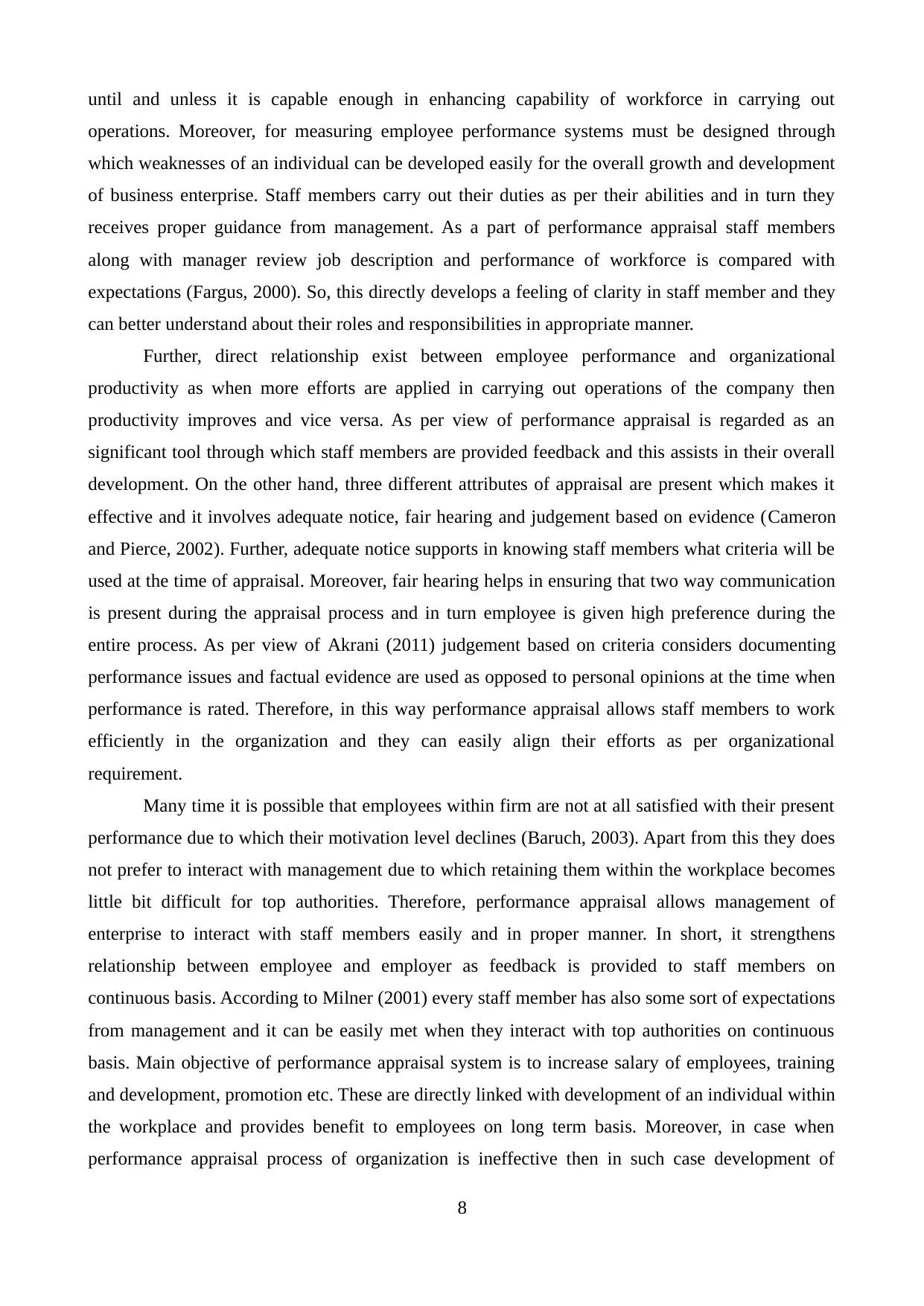
until and unless it is capable enough in enhancing capability of workforce in carrying out
operations. Moreover, for measuring employee performance systems must be designed through
which weaknesses of an individual can be developed easily for the overall growth and development
of business enterprise. Staff members carry out their duties as per their abilities and in turn they
receives proper guidance from management. As a part of performance appraisal staff members
along with manager review job description and performance of workforce is compared with
expectations (Fargus, 2000). So, this directly develops a feeling of clarity in staff member and they
can better understand about their roles and responsibilities in appropriate manner.
Further, direct relationship exist between employee performance and organizational
productivity as when more efforts are applied in carrying out operations of the company then
productivity improves and vice versa. As per view of performance appraisal is regarded as an
significant tool through which staff members are provided feedback and this assists in their overall
development. On the other hand, three different attributes of appraisal are present which makes it
effective and it involves adequate notice, fair hearing and judgement based on evidence (Cameron
and Pierce, 2002). Further, adequate notice supports in knowing staff members what criteria will be
used at the time of appraisal. Moreover, fair hearing helps in ensuring that two way communication
is present during the appraisal process and in turn employee is given high preference during the
entire process. As per view of Akrani (2011) judgement based on criteria considers documenting
performance issues and factual evidence are used as opposed to personal opinions at the time when
performance is rated. Therefore, in this way performance appraisal allows staff members to work
efficiently in the organization and they can easily align their efforts as per organizational
requirement.
Many time it is possible that employees within firm are not at all satisfied with their present
performance due to which their motivation level declines (Baruch, 2003). Apart from this they does
not prefer to interact with management due to which retaining them within the workplace becomes
little bit difficult for top authorities. Therefore, performance appraisal allows management of
enterprise to interact with staff members easily and in proper manner. In short, it strengthens
relationship between employee and employer as feedback is provided to staff members on
continuous basis. According to Milner (2001) every staff member has also some sort of expectations
from management and it can be easily met when they interact with top authorities on continuous
basis. Main objective of performance appraisal system is to increase salary of employees, training
and development, promotion etc. These are directly linked with development of an individual within
the workplace and provides benefit to employees on long term basis. Moreover, in case when
performance appraisal process of organization is ineffective then in such case development of
8
operations. Moreover, for measuring employee performance systems must be designed through
which weaknesses of an individual can be developed easily for the overall growth and development
of business enterprise. Staff members carry out their duties as per their abilities and in turn they
receives proper guidance from management. As a part of performance appraisal staff members
along with manager review job description and performance of workforce is compared with
expectations (Fargus, 2000). So, this directly develops a feeling of clarity in staff member and they
can better understand about their roles and responsibilities in appropriate manner.
Further, direct relationship exist between employee performance and organizational
productivity as when more efforts are applied in carrying out operations of the company then
productivity improves and vice versa. As per view of performance appraisal is regarded as an
significant tool through which staff members are provided feedback and this assists in their overall
development. On the other hand, three different attributes of appraisal are present which makes it
effective and it involves adequate notice, fair hearing and judgement based on evidence (Cameron
and Pierce, 2002). Further, adequate notice supports in knowing staff members what criteria will be
used at the time of appraisal. Moreover, fair hearing helps in ensuring that two way communication
is present during the appraisal process and in turn employee is given high preference during the
entire process. As per view of Akrani (2011) judgement based on criteria considers documenting
performance issues and factual evidence are used as opposed to personal opinions at the time when
performance is rated. Therefore, in this way performance appraisal allows staff members to work
efficiently in the organization and they can easily align their efforts as per organizational
requirement.
Many time it is possible that employees within firm are not at all satisfied with their present
performance due to which their motivation level declines (Baruch, 2003). Apart from this they does
not prefer to interact with management due to which retaining them within the workplace becomes
little bit difficult for top authorities. Therefore, performance appraisal allows management of
enterprise to interact with staff members easily and in proper manner. In short, it strengthens
relationship between employee and employer as feedback is provided to staff members on
continuous basis. According to Milner (2001) every staff member has also some sort of expectations
from management and it can be easily met when they interact with top authorities on continuous
basis. Main objective of performance appraisal system is to increase salary of employees, training
and development, promotion etc. These are directly linked with development of an individual within
the workplace and provides benefit to employees on long term basis. Moreover, in case when
performance appraisal process of organization is ineffective then in such case development of
8

workforce is not at all possible for enterprise and it can adversely affect productivity of entire
organization (SIDDIQUI, 2012).
1.4 Factors affecting employee motivation
As per view of Govern and Petri (2012) large number of factors are present which affects
employee motivation and in turn by considering these factors it is possible for company to satisfy
need of its target market in efficient manner. Workplace culture is considered as one of the most
crucial factor as in case when proper culture is provided to employees for working then it enhances
their motivation level and they take active participation in the affairs of company. Apart from this,
organization such as Marriott is well known for its workplace culture as through this firm is
retaining its valuable workforce for longer period of time. Moreover, when employees are allowed
to communicate freely with management and other individuals working in company then it also
enhances their motivation level (Woodruffe, 2000). Training and development opportunities
provided to employees also affects motivation level of staff members as when larger efforts are
applied by management in developing overall skills along with knowledge of employees then it
leads to higher job satisfaction.
On the other hand, performance appraisal as a system is effective enough in enhancing
motivation level of workforce as through this it becomes easy to identify the areas where staff
member is underperforming and in turn focuses on internal weaknesses for development. However
Afiouni (2013) argued that development opportunities provided to staff members also acts as
motivation tool and by knowing overall performance of individual within the workplace growth
opportunities are provided to employees and this encourages them to apply larger efforts in carrying
out operations of the enterprise. Due to this specific reason performance appraisal system is given
higher importance as through this valuable human resource of enterprise can be managed in
effective manner. Moreover, it enhances confidence and builds trust in staff members towards
management which can be regarded as one of the main objective of every organization (Fargus,
2000).
1.5 Conclusion
From the literature review being carried out it can be said that performance appraisal has
direct influence on employee motivation as when management takes initiative for measuring overall
performance of the staff members then it directly leads to rise in their motivation level and allows
them to work for the betterment of organization. In short it can be regarded as key to organization
success and allows management to grab opportunities present in the market through proper support
of its workforce. Apart from this, overall process and model of performance appraisal is effective as
through this each and every activity carried out by staff members can be monitored easily and
9
organization (SIDDIQUI, 2012).
1.4 Factors affecting employee motivation
As per view of Govern and Petri (2012) large number of factors are present which affects
employee motivation and in turn by considering these factors it is possible for company to satisfy
need of its target market in efficient manner. Workplace culture is considered as one of the most
crucial factor as in case when proper culture is provided to employees for working then it enhances
their motivation level and they take active participation in the affairs of company. Apart from this,
organization such as Marriott is well known for its workplace culture as through this firm is
retaining its valuable workforce for longer period of time. Moreover, when employees are allowed
to communicate freely with management and other individuals working in company then it also
enhances their motivation level (Woodruffe, 2000). Training and development opportunities
provided to employees also affects motivation level of staff members as when larger efforts are
applied by management in developing overall skills along with knowledge of employees then it
leads to higher job satisfaction.
On the other hand, performance appraisal as a system is effective enough in enhancing
motivation level of workforce as through this it becomes easy to identify the areas where staff
member is underperforming and in turn focuses on internal weaknesses for development. However
Afiouni (2013) argued that development opportunities provided to staff members also acts as
motivation tool and by knowing overall performance of individual within the workplace growth
opportunities are provided to employees and this encourages them to apply larger efforts in carrying
out operations of the enterprise. Due to this specific reason performance appraisal system is given
higher importance as through this valuable human resource of enterprise can be managed in
effective manner. Moreover, it enhances confidence and builds trust in staff members towards
management which can be regarded as one of the main objective of every organization (Fargus,
2000).
1.5 Conclusion
From the literature review being carried out it can be said that performance appraisal has
direct influence on employee motivation as when management takes initiative for measuring overall
performance of the staff members then it directly leads to rise in their motivation level and allows
them to work for the betterment of organization. In short it can be regarded as key to organization
success and allows management to grab opportunities present in the market through proper support
of its workforce. Apart from this, overall process and model of performance appraisal is effective as
through this each and every activity carried out by staff members can be monitored easily and
9
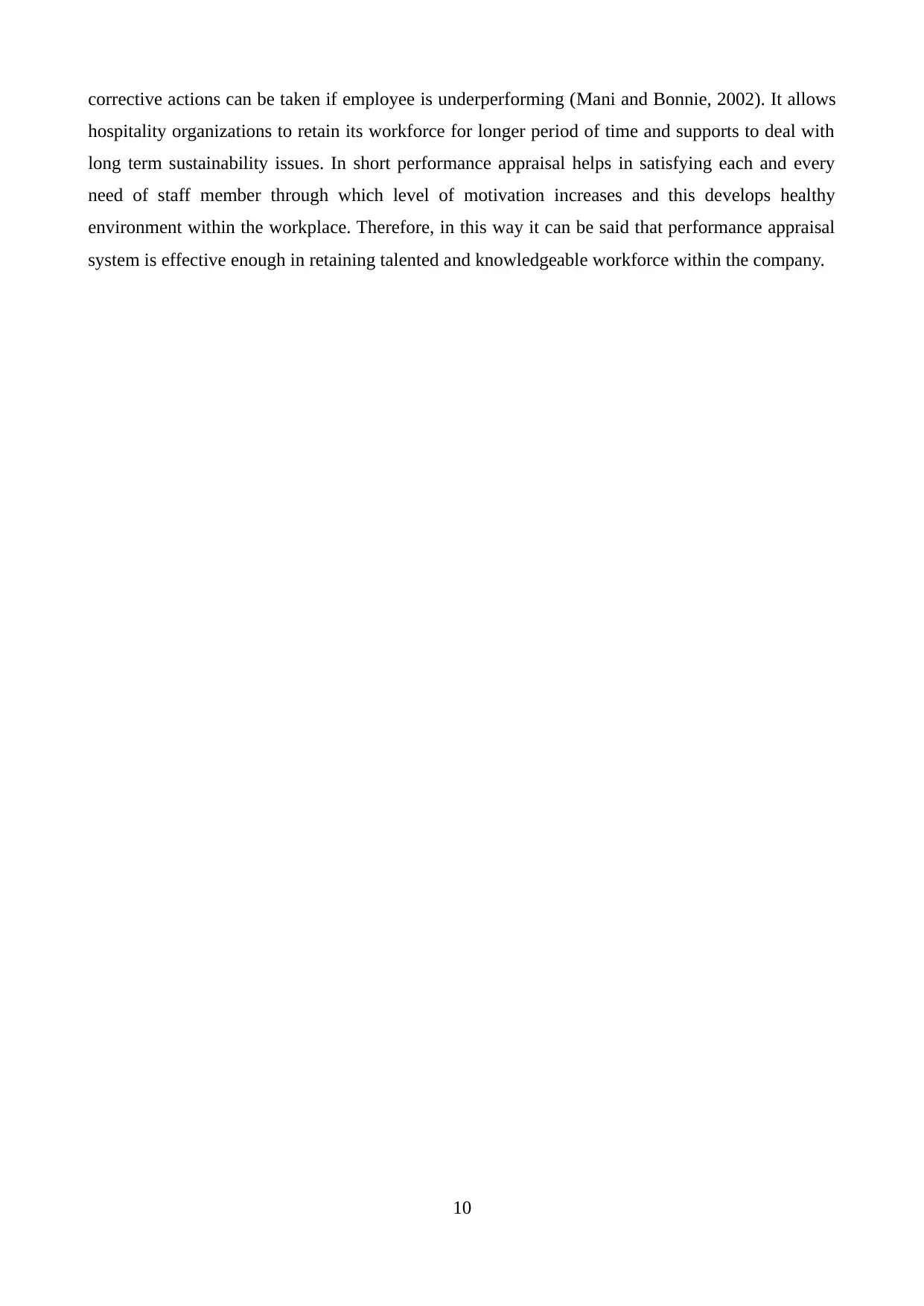
corrective actions can be taken if employee is underperforming (Mani and Bonnie, 2002). It allows
hospitality organizations to retain its workforce for longer period of time and supports to deal with
long term sustainability issues. In short performance appraisal helps in satisfying each and every
need of staff member through which level of motivation increases and this develops healthy
environment within the workplace. Therefore, in this way it can be said that performance appraisal
system is effective enough in retaining talented and knowledgeable workforce within the company.
10
hospitality organizations to retain its workforce for longer period of time and supports to deal with
long term sustainability issues. In short performance appraisal helps in satisfying each and every
need of staff member through which level of motivation increases and this develops healthy
environment within the workplace. Therefore, in this way it can be said that performance appraisal
system is effective enough in retaining talented and knowledgeable workforce within the company.
10
Secure Best Marks with AI Grader
Need help grading? Try our AI Grader for instant feedback on your assignments.
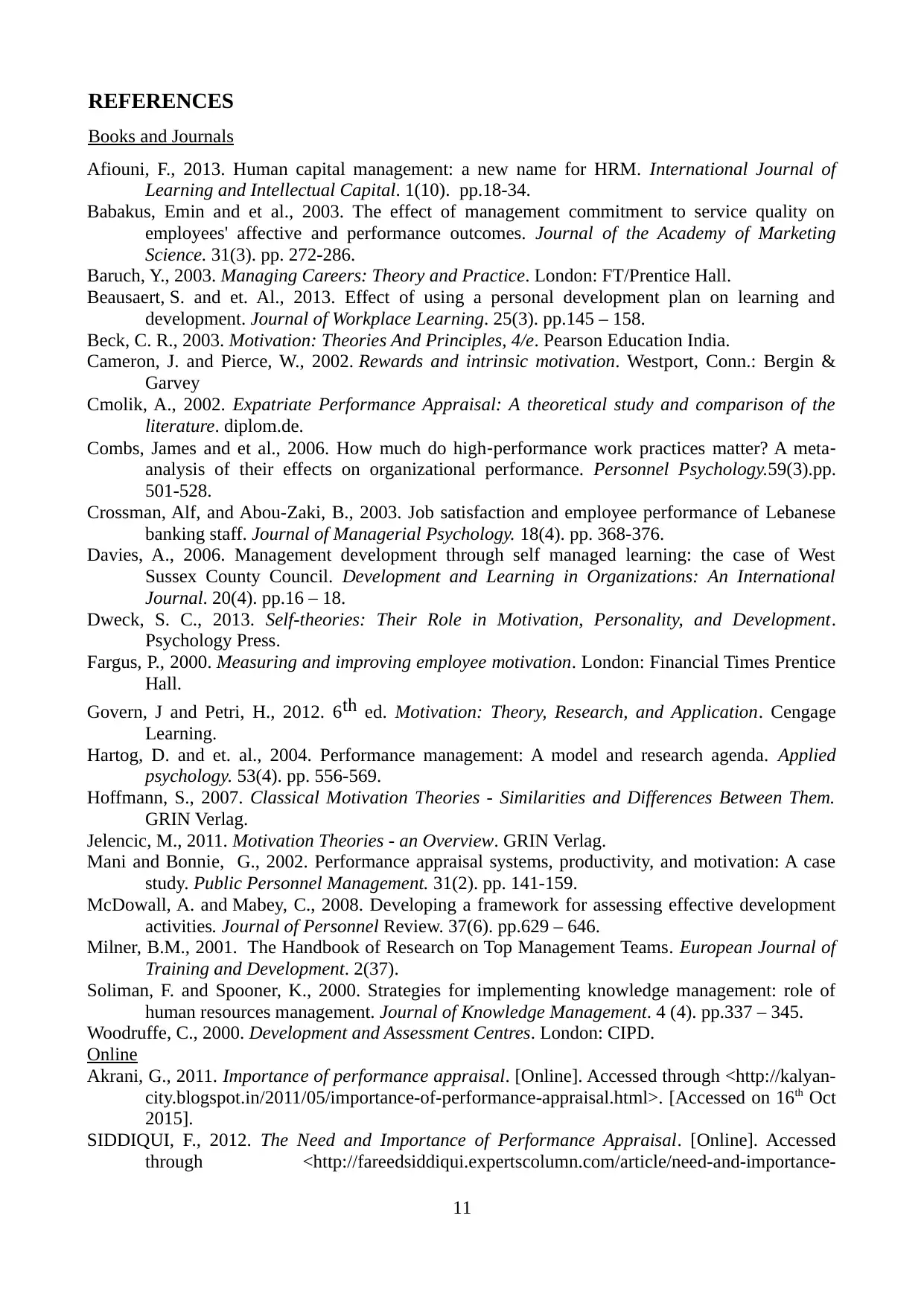
REFERENCES
Books and Journals
Afiouni, F., 2013. Human capital management: a new name for HRM. International Journal of
Learning and Intellectual Capital. 1(10). pp.18-34.
Babakus, Emin and et al., 2003. The effect of management commitment to service quality on
employees' affective and performance outcomes. Journal of the Academy of Marketing
Science. 31(3). pp. 272-286.
Baruch, Y., 2003. Managing Careers: Theory and Practice. London: FT/Prentice Hall.
Beausaert, S. and et. Al., 2013. Effect of using a personal development plan on learning and
development. Journal of Workplace Learning. 25(3). pp.145 – 158.
Beck, C. R., 2003. Motivation: Theories And Principles, 4/e. Pearson Education India.
Cameron, J. and Pierce, W., 2002. Rewards and intrinsic motivation. Westport, Conn.: Bergin &
Garvey
Cmolik, A., 2002. Expatriate Performance Appraisal: A theoretical study and comparison of the
literature. diplom.de.
Combs, James and et al., 2006. How much do high‐performance work practices matter? A meta‐
analysis of their effects on organizational performance. Personnel Psychology.59(3).pp.
501-528.
Crossman, Alf, and Abou-Zaki, B., 2003. Job satisfaction and employee performance of Lebanese
banking staff. Journal of Managerial Psychology. 18(4). pp. 368-376.
Davies, A., 2006. Management development through self managed learning: the case of West
Sussex County Council. Development and Learning in Organizations: An International
Journal. 20(4). pp.16 – 18.
Dweck, S. C., 2013. Self-theories: Their Role in Motivation, Personality, and Development.
Psychology Press.
Fargus, P., 2000. Measuring and improving employee motivation. London: Financial Times Prentice
Hall.
Govern, J and Petri, H., 2012. 6th ed. Motivation: Theory, Research, and Application. Cengage
Learning.
Hartog, D. and et. al., 2004. Performance management: A model and research agenda. Applied
psychology. 53(4). pp. 556-569.
Hoffmann, S., 2007. Classical Motivation Theories - Similarities and Differences Between Them.
GRIN Verlag.
Jelencic, M., 2011. Motivation Theories - an Overview. GRIN Verlag.
Mani and Bonnie, G., 2002. Performance appraisal systems, productivity, and motivation: A case
study. Public Personnel Management. 31(2). pp. 141-159.
McDowall, A. and Mabey, C., 2008. Developing a framework for assessing effective development
activities. Journal of Personnel Review. 37(6). pp.629 – 646.
Milner, B.M., 2001. The Handbook of Research on Top Management Teams. European Journal of
Training and Development. 2(37).
Soliman, F. and Spooner, K., 2000. Strategies for implementing knowledge management: role of
human resources management. Journal of Knowledge Management. 4 (4). pp.337 – 345.
Woodruffe, C., 2000. Development and Assessment Centres. London: CIPD.
Online
Akrani, G., 2011. Importance of performance appraisal. [Online]. Accessed through <http://kalyan-
city.blogspot.in/2011/05/importance-of-performance-appraisal.html>. [Accessed on 16th Oct
2015].
SIDDIQUI, F., 2012. The Need and Importance of Performance Appraisal. [Online]. Accessed
through <http://fareedsiddiqui.expertscolumn.com/article/need-and-importance-
11
Books and Journals
Afiouni, F., 2013. Human capital management: a new name for HRM. International Journal of
Learning and Intellectual Capital. 1(10). pp.18-34.
Babakus, Emin and et al., 2003. The effect of management commitment to service quality on
employees' affective and performance outcomes. Journal of the Academy of Marketing
Science. 31(3). pp. 272-286.
Baruch, Y., 2003. Managing Careers: Theory and Practice. London: FT/Prentice Hall.
Beausaert, S. and et. Al., 2013. Effect of using a personal development plan on learning and
development. Journal of Workplace Learning. 25(3). pp.145 – 158.
Beck, C. R., 2003. Motivation: Theories And Principles, 4/e. Pearson Education India.
Cameron, J. and Pierce, W., 2002. Rewards and intrinsic motivation. Westport, Conn.: Bergin &
Garvey
Cmolik, A., 2002. Expatriate Performance Appraisal: A theoretical study and comparison of the
literature. diplom.de.
Combs, James and et al., 2006. How much do high‐performance work practices matter? A meta‐
analysis of their effects on organizational performance. Personnel Psychology.59(3).pp.
501-528.
Crossman, Alf, and Abou-Zaki, B., 2003. Job satisfaction and employee performance of Lebanese
banking staff. Journal of Managerial Psychology. 18(4). pp. 368-376.
Davies, A., 2006. Management development through self managed learning: the case of West
Sussex County Council. Development and Learning in Organizations: An International
Journal. 20(4). pp.16 – 18.
Dweck, S. C., 2013. Self-theories: Their Role in Motivation, Personality, and Development.
Psychology Press.
Fargus, P., 2000. Measuring and improving employee motivation. London: Financial Times Prentice
Hall.
Govern, J and Petri, H., 2012. 6th ed. Motivation: Theory, Research, and Application. Cengage
Learning.
Hartog, D. and et. al., 2004. Performance management: A model and research agenda. Applied
psychology. 53(4). pp. 556-569.
Hoffmann, S., 2007. Classical Motivation Theories - Similarities and Differences Between Them.
GRIN Verlag.
Jelencic, M., 2011. Motivation Theories - an Overview. GRIN Verlag.
Mani and Bonnie, G., 2002. Performance appraisal systems, productivity, and motivation: A case
study. Public Personnel Management. 31(2). pp. 141-159.
McDowall, A. and Mabey, C., 2008. Developing a framework for assessing effective development
activities. Journal of Personnel Review. 37(6). pp.629 – 646.
Milner, B.M., 2001. The Handbook of Research on Top Management Teams. European Journal of
Training and Development. 2(37).
Soliman, F. and Spooner, K., 2000. Strategies for implementing knowledge management: role of
human resources management. Journal of Knowledge Management. 4 (4). pp.337 – 345.
Woodruffe, C., 2000. Development and Assessment Centres. London: CIPD.
Online
Akrani, G., 2011. Importance of performance appraisal. [Online]. Accessed through <http://kalyan-
city.blogspot.in/2011/05/importance-of-performance-appraisal.html>. [Accessed on 16th Oct
2015].
SIDDIQUI, F., 2012. The Need and Importance of Performance Appraisal. [Online]. Accessed
through <http://fareedsiddiqui.expertscolumn.com/article/need-and-importance-
11

performance-appraisal-business-organization>. [Accessed on 16th Oct 2015].
12
12
1 out of 12
Related Documents
Your All-in-One AI-Powered Toolkit for Academic Success.
+13062052269
info@desklib.com
Available 24*7 on WhatsApp / Email
![[object Object]](/_next/static/media/star-bottom.7253800d.svg)
Unlock your academic potential
© 2024 | Zucol Services PVT LTD | All rights reserved.





